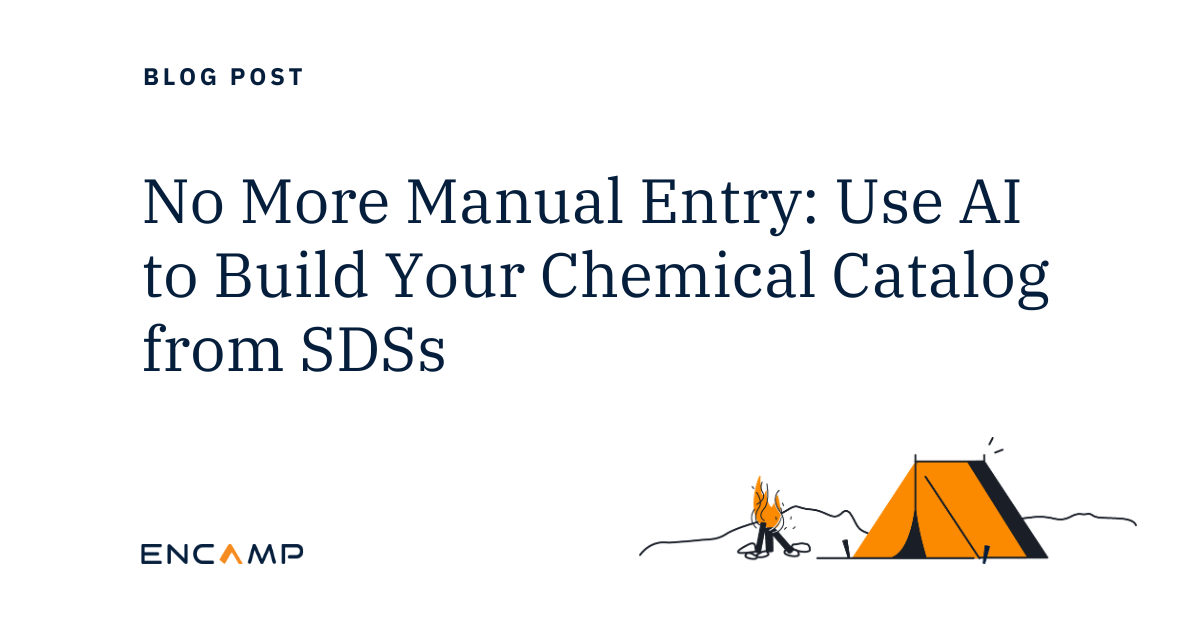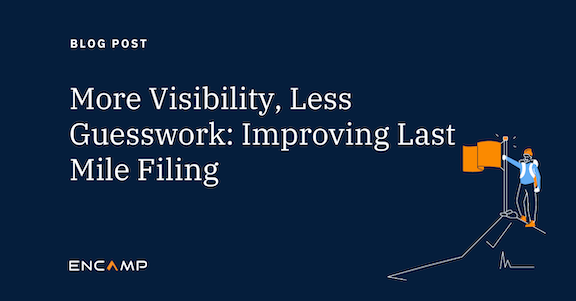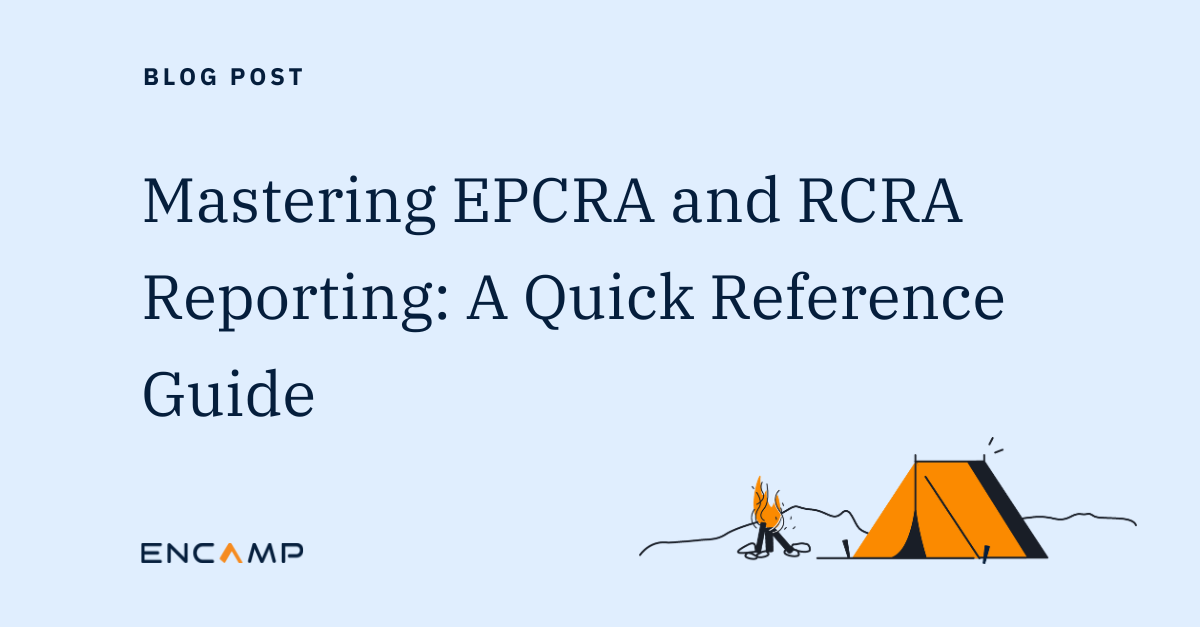If your facility produces hazardous waste, it’s up to you to know what that waste is made up of, and how to manage it in a way that protects the health of your employees and the environment.
A critical step to getting a clear picture of your waste is completing a waste characterization. This process typically requires lab testing, a deep understanding of the waste generation process, and rigorous documentation along the way.
In this article, Encamp’s Director of Environmental Compliance, Jackie Velasquez, P.E., explains how waste characterizations are performed, why they matter, and how to interpret your results.
Want an in-depth guide to identifying hazardous waste, determining generator status, and best practices managing hazardous waste data and common violations? Take the Comprehensive Guide to RCRA Hazardous Waste Compliance with you.
Want a reference point to take with you? The Comprehensive Guide to Waste
Why it’s important to know your waste
Facilities need comprehensive knowledge about the waste they produce, including its composition and whether it meets the definition of a hazardous waste, which may require laboratory testing.
Beyond understanding the generation process, it’s important to be able to justify your characterization. That’s why it’s critical that your facility keeps careful documentation around processes for future inspections, audits, or for reference by the next EHS professional to fill your role.
Laboratory testing: a key step in assessing waste toxicity
In addition to screening your waste for listing or other hazardous characteristics, a toxicity determination is typically made by laboratory analysis via the Toxicity Characteristic Leaching Procedure (TCLP), or Test Method 1311, found in the U.S. EPA publication SW-846.
This method demonstrates a waste’s likelihood to leach specific toxic metals, organic compounds, or pesticides into the soil or groundwater under typical conditions in an ordinary sanitary landfill.
What state should waste samples take?
A TCLP test can be used to analyze samples in various states, whether they’re completely solid, completely liquid, or multi-phase (such as a sludge sample).
Liquid samples
The TCLP protocol allows for samples with less than 0.5% solids to have only the filtered liquid analyzed, without needing to complete a leaching test.
Solid and multi-phase samples
For solid and mixed-phase samples, the solid portion is mixed with an extraction liquid equal to 20 times the weight of the original sample being tested. This mixture is then placed into a tumbler and mixed for a minimum of 18 hours to simulate the leaching action of precipitation seeping through the waste in a landfill.
When the tumbling is completed, the solid portion is removed and discarded, and the liquid portion is combined with any liquid filtered from the original sample. This final liquid mixture is analyzed using specific methods for metals and chemical compounds. The results are reported in milligrams per liter (mg/L), which is equivalent to parts per million (ppm).
What is a totals analysis, and when is it used?
Whereas a TCLP test analyzes for your waste’s likelihood to leach toxic compounds into the environment, a total waste analysis (or ‘totals analysis’) tests for the total concentration of a compound present in a sample. These tests will yield different results to TCLP tests.
Thanks to shorter sample turnaround times and lower costs, a totals analysis is typically used for screening samples early in a characterization. In some cases, a prior totals analysis may be available from a predictable or single-source generation process.
What is the ‘Rule of 20’, and how can I use it to measure toxicity?
For screening, the ‘Rule of 20’ is a common tool for equating a totals analysis with a predicted TCLP result.
But what is it, exactly?
The TCLP procedure requires that the solid portion of a sample be mixed with a volume of extraction fluid equal to 20 times the weight of the sample. So, if we use a conservative assumption that all of a tested compound in a sample leached into the extraction fluid during the tumbling process, then we can calculate that the concentration of the compound in the extraction fluid will always be 20 times less than its original concentration in the sample.
This 20:1 dilution in the TCLP procedure allows waste-producing facilities to compare totals results to the RCRA TCLP toxicity limits (available in 40 CFR 261.24) by dividing total concentration results by 20.
What do my Rule of 20 results mean?
If the result of your Rule of 20 test is less than the RCRA toxicity limit for a given constituent, the waste is not a toxicity characteristic waste for this compound. Even if all of the constituent leached into the extraction fluid during the TCLP process, the amount isn’t sufficient to exceed the TCLP limit for that constituent.
Arsenic testing: the Rule of 20 in action
For example, the RCRA TCLP toxicity limit for Arsenic is 5.0 mg/L (ppm). If the Arsenic totals analysis for a waste sample is 70 ppm, the sample could not leach enough Arsenic into the sample extraction fluid to exceed the TCLP limit, as 20x the TCLP limit for Arsenic is 100 ppm. In this case, the waste may require additional analysis for other chemical constituents, but it is under the applicable toxicity limit for Arsenic.
Exceptions to the Rule of 20
The Rule of 20 has a few notable caveats. In cases where a totals result exceeds 20 times the RCRA TCLP toxicity limit, we recommend performing additional sampling, as the waste may be hazardous (and pending further analysis, the waste should be treated as such). And although the Rule of 20 serves as a reliable screening tool, a TSDF will need to make the final determination on whether additional sampling is required prior to profile acceptance.
Ready to simplify your waste compliance? Encamp solves the complexity of environmental compliance with high-tech solutions and high-touch expert support and is on a mission to create a world where good for business can equal good for the environment. We help enterprises transform compliance programs and human processes into a technology-driven system that lays the foundation for accurate and ongoing environmental compliance. Request a demo to learn more.
Jackie Velazquez
Jackie has worked in the environmental industry since 2008 and came to Encamp in 2021 after more than six years at Marathon Petroleum Corporation, where she was an environmental supervisor and later an Advanced Environmental Professional for state and federal regulatory advocacy support. Prior to Marathon, Jackie was a manufacturing environmental engineer for Ford Motor Company, and a consulting environmental engineer for Leggette, Brashears & Graham, Inc. She is a graduate of Marquette University, where she earned a B.S. in Civil & Environmental Engineering.



